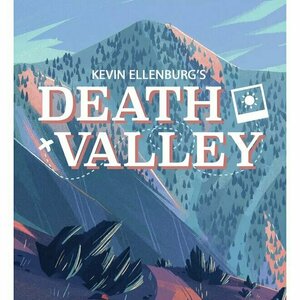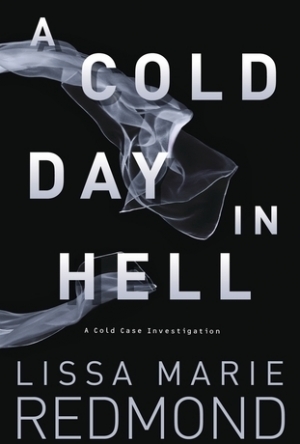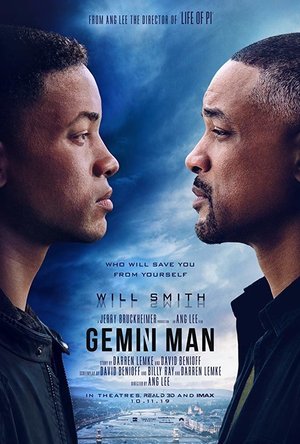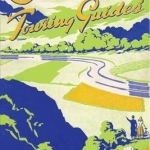
Cycling Touring Guide: Central England
Book
The revised edition of the classic cycling guide by Harold Briercliffe of 1949. Used as the...
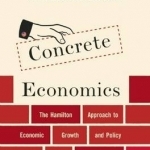
Concrete Economics: The Hamilton Approach to Economic Growth and Policy
Stephen S. Cohen and J. Bradford DeLong
Book
"an excellent new book" -- Paul Krugman, The New York Times History, not ideology, holds the key to...

RocketMan Transit App
Navigation and Lifestyle
App
RocketMan recognizes public transit stops and bike sharing stations around you. Tap the bus or train...
Purple Phoenix Games (2266 KP) rated Death Valley in Tabletop Games
Jan 18, 2022
Death Valley is a game for 1-2 players in which you are documenting your journey across the Death Valley park. You will see different sights on your journey, and add cherished memories to your scrapbook. The player who amasses the most points by the end of the game is the winner! To setup for a game, shuffle the deck of Feature cards and reveal one face-up while the rest remain in a face-down deck. These cards make up the Desert. That’s it. The game is ready to start! Choose a starting player and get to sight-seeing!
Throughout the game, players will be adding Feature cards to their Journey tableau (places they have visited) and their Scrapbook tableau (the more memorable locations). On your turn, you will perform one of 2 actions: Travel or Rest. When you choose to Travel, you will select either the Feature card from the Desert (the face-up card), or draw the top card from the face-down deck and add it to your Journey. Conversely, when you choose to Rest, you will move a Feature card from your Journey into your Scrapbook. When moving Feature cards to your Scrapbook, you are allowed to hide other cards from your Journey underneath that card. Hiding cards can be beneficial for end-game points, or for preventing you from Busting. Many Feature cards have additional text at the bottom, that either provides ongoing abilities for the remainder of the game, or that provide extra scoring abilities at the end of the game. Choosing which Feature cards to move when and where is key!
After you have performed your chosen Action, you check to see if you Bust. If you have 3 Feature cards of the same type in your Journey and Scrapbook, you Bust! To resolve a Bust, you will discard from the game the right-most card in your Journey, and then will re-shuffle any remaining Journey cards back into the draw deck. So there’s a small element of push-your-luck in here! Once you resolve a Bust (if necessary), you will refresh the Desert – reveal a new face-up card if you just took the face-up card this turn. Your turn then ends, and play moves to your opponent. The game continues in this fashion, with players drawing/placing/moving Feature cards in their 2 tableaus, until only 1 card remains in the Desert. Points are then tallied: 1 point per Star on cards visible in your Journey, and points based on the extra scoring abilities of cards in your Journey and/or Scrapbook. The player with the highest score is declared the winner!
So, let’s get into this gameplay. For being a 2-player game, I appreciate that it’s not necessarily directly competitive. Yes, you want to score more points at the end of the game, but there really isn’t any player interaction, which keeps the energy level of the game more low-key. That being said, it’s decently strategic. Some Feature cards provide on-going abilities that can be used throughout the game, and can help you get some benefit out of a Bust. Certain card abilities rely on adjacency of other cards, so you have to know when/where to place a card to get the most points for the end of the game. That being said, you also have to make sure you don’t Bust. Luckily, you don’t resolve/check for a Bust until after you have performed your action, so perhaps you are able to sneak by with some clever planning. One part of the gameplay that misses the mark for me is the fact that you can only perform 1 Action per turn. I feel like that can really inhibit your ability to strategize, and makes it difficult to feel like you’re accomplishing something on your turns. Maybe if players had to perform both Actions per turn (either Travel/Rest, or vice versa), it would offer a few more options in terms of strategy. I just personally feel like taking only 1 Action per turn makes the gameplay a little too choppy, and makes it hard to really get into – especially when the game itself is so short. Maybe I’m not thinking strategically enough, but these are my thoughts thus far with Death Valley!
Components. As to be expected from ButtonShy – excellent quality of the cards and wallet. The artwork is colorful and thematic, and I just like looking at the different locations represented in the game. This game is satisfying to look at, and it earns high marks from me. Another neat thing? Each Feature card has a little interesting fact about its location, so you can learn a neat tidbit while playing the game!
Nothing can really compare to seeing Death Valley in person, but this game does offer a nice representation. The beauty of the location artwork coupled with the interesting facts has me intrigued outside of the game itself. The gameplay isn’t necessarily a home-run in my eyes, but it is strategic enough that I know I’ll keep pulling this one out from time to time. There is a solo mode, as well as a variant to give you more of a press-your-luck element, and I will definitely be trying those to see if they change my thoughts on this game. But for the time being, Purple Phoenix Games gives Death Valley a singed 4 / 6.
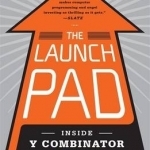
The Launch Pad: Inside Y Combinator, Silicon Valley's Most Exclusive School for Startups
Book
In The Launch Pad, Randall Stross, author of eBoys and Planet Google, takes a behind-the-scenes look...
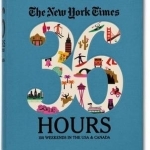
The New York Times, 36 Hours: 150 Weekends in the USA & Canada
Book
This book covers 150 North American cities from the "New York Times'" popular travel column. To...
Kristy H (1252 KP) rated A Cold Day in Hell in Books
Jan 29, 2018
I read a lot of mysteries and while there are thankfully more strong female detectives coming on the scene (see Kristen Lepionka's Roxanne Weary and Emily Littlejohn's Gemma Monroe, for instance), they are still few and far between. While Lauren Riley may still be finding herself (there's a lot of side coverage of emotional entanglements and relationships here), I still love finding and championing a complicated, real, strong female detective.
Lauren's PI case is really the star of the show, and it's interesting and engaging throughout the entire novel. It keeps you guessing throughout, questioning whether David did it or not, and who else played a key role in Katherine and Anthony Vine lives. Nothing is cut or dried.
Also fascinating is Lauren's main cold case. While you could argue some of it ties up neatly, it doesn't go as expected, per se, if that makes sense, and the characters involved are intriguing and different. All the cases kept me interested as I read. A lot certainly happens in this novel, between Lauren's work and personal life. Nothing is boring, and there's never really a dull moment, especially once you get into the swing of things and realize that the book covers both her personal life and her work life in-depth. It also tells the story from more than Lauren's POV, even if she's the main focus, which works surprisingly well.
I don't think it's a spoiler to say that the book culminates in a trial related to Lauren's PI case, and it's a great, suspenseful, incredibly well-written piece of work. The courtroom scenes were so well-done and really had me on the edge of my seat. One of the things I loved about this novel was how I could so easily picture each of these characters-- each is well-described and fleshed out. Redmond writes darn good trial scenes (and a darn good book), and I was frantically flipping the pages to see how things would turn out.
It wasn't until I finished the book that I learned the author is a retired homicide detective, but it definitely shows as you read. The novel is written expertly in terms of police and courtroom procedure, but still enjoyable in terms of the characters. There is a lot of personal "stuff" in terms of Lauren; this will be a little different if you are used to the Bosch type of detective (the love of my life and my hero). Still, it's completely refreshing to see a complicated female lead detective, and, as mentioned, so nice to be reading more of these stories. I grew to really love Lauren.
The courtroom scenes are great, and a lot will keep you guessing. Sure, some of the cold cases wrap up what seem a little easily, but even Lauren addresses that as she works. I read some reviews that Joe Wheeler is a cliche character, and I guess I could see where people get that, but for me, society as of late seems to be showing us everyday that these sort of angry, abusive men truly exist. Everywhere. To me, Joe was a sadly realistic portrayal of a horrible man, and his slow, boiling anger only added to the tension of the entire novel.
Overall, I really enjoyed this one. It looks like it's going to be a series, and it ends with some unfinished issues that make me even more eager for book two.
I received a copy of this novel from the publisher and Netgalley in return for an unbiased review.
Bob Mann (459 KP) rated Gemini Man (2019) in Movies
Nov 10, 2019
But all is not well when Henry's 'one for the road' hit turns out to not be quite what it seems.
Teaming up with marina manager Danny (Danny??) Zakarweski (Mary Elizabeth Winstead), the pair go on the run from operatives of a government-funded black-ops organization called Gemini. Gemini is a private semi-military organization (didn't we just go here with "Angel Has Fallen"?!). These 'baddie goodies' would rather see Henry - and all who know him - fed to the fishes rather than have him catching them.
But one of these guys, under the direct command of Gemini-boss Clay Verris (Clive Owen), looks kinda familiar...
Let's focus on the positives for a minute. This is a spy movie that has all of the polish that the recent "Angel has Fallen" didn't have. Some nice photogenic locations fly in and out again (Georgia, Budapest and Colombia: the latter for no obvious reason I can remember!). It occasionally reminded me of a glossy Bond film, but without Bond.
There are also some high-class special effects (the special effects coordinator is Mark Hawker). A moonlit CGI Gulfstream with a zoom into the cockpit is particularly impressive.
Some of the action set pieces also entertain. A Will-on-Will bike chase is well done, and I've not seen a bike used as a hand-to-hand weapon in this way before!
And Will Smith is no doubt a class act, with his 'youngification' (I'm not sure what the official word is) also being effectively done. I also enjoyed Mary Elizabeth Winstead, who was great in "10 Cloverfield Lane". The lady has real screen presence.
But man oh man, that script. Let's name the guilty parties in this film: the scriptwriters David Benioff (Game of Thrones), Darren Lemke and Billy Ray. (I'll put Ray last in the list, since the story was by Benioff and Lemke and this has the smell to me of Ray - who has a history of some great scripts like Captain Phillips under his name - being drafted in to steady a listing ship).
Some of the dialogue in this film is not just a bit dodgy. It's head in the hands groan-worthy (and I actually did at times: fortunately the cinema was barely half full and I was on my own in the whole row). And some of it is just plain offensive. Henry meets his old pal Jack Willis (Douglas Hodge) on his yacht where he explains his wife is on a trip to Paris as a scantily clad dolly-bird wanders past. Henry comically rolls his eyes at this adulterous behaviour, with some sort of "Jack, what are you loike!" comment. Cringe-worthy.
Will Smith, Mary Elizabeth Winstead and Benedict Wong (their ally, adding some comic relief) are clearly good actors. But the script often makes them look utterly vacuous and stupid. And Lee seems to have a "good enough, move on" approach to the filming. One jaw-dropping moment has Will Smith telling the others that they are going to Budapest. "Budapest?" Winstead and Wong are supposed to say in union, but mistime it. "Can we do that again?". Nope. It's on the screen.
As for Clive Owen... sorry, he's really not in the same acting league, and the script does him even fewer favours. As he says at one point "It's like the Hindenburg crashing into the Titanic". I couldn't have put it better myself.
"Uncanny Valley". You know this phrase. The Princess Leia and Moff Tarkin scenes in "Rogue One" is the classic example. Effects that don't quite work on the big screen. "But" - you say to yourself - "Dr Bob just said that the 'youngification' of Will Smith was done really well?". And I'll repeat again that it was. It's on a par with Samuel L. Jackson's 'youngification' in "Captain Marvel". Where something strange happens is in the film's overall projection. Ang Lee has tried again with his experiment of filming at a massive 120 frames per second..... five times the normal movie frame rate of 24 fps. And the quality of the picture - particularly during high-speed action scenes - becomes outstandingly good! But equally it just doesn't 'look right'.
When the human eye presumably works at an equivalent "fps" of thousands of 'frames per second' you'd think that it should all be fine. But for some reason I just found it distracting. Presumably the audiences for "The Jazz Singer" thought the same about sound; and those for "Gone with the Wind" and the "Wizard of Oz" about colour. Maybe we've seen the future, and its the new norm that we just need to get used to. We'll see.
Ang Lee's "Life of Pi" was extraordinary. His "Hulk" was one of the poorest of the Marvel canon. Unfortunately, this movie is at the "Hulk" end of the spectrum. Which is a real shame. The duo of the 51 year old Smith and the 35 year old Winstead work really well together. They have great chemistry, but, you'll be relieved to hear, avoid any icky love interest.
What a shame. With a different script, and some good production values, this could have been a very different story.
(For the full graphical review, please check out https://bob-the-movie-man.com/2019/10/18/one-manns-movies-film-review-gemini-man-2019/ )
5 Minute Movie Guy (379 KP) rated Scary Stories to Tell in the Dark (2019) in Movies
Sep 16, 2019
In Mill Valley, Pennsylvania in 1968, a group of teenage friends fleeing from a band of bullies hide out in an abandoned haunted house on Halloween night. They know the story of this house well, whose folklore is rooted in the origins of their own small town. It was once owned by the wealthy Bellows Family, who according to urban legend, locked away their own daughter, Sarah Bellows, inside the cellar of their home. Sarah had been accused of killing the town’s children, and so her family kept her hidden away and attempted to erase her from existence, even removing her from their own family portraits. According to legend, Sarah wrote a book of horror stories and would read them aloud through the walls of her room to frighten the local townspeople.
While inside this haunted house, our group of protagonists; Stella (Zoe Colletti), Ramón (Michael Garza), Auggie (Gabriel Rush), and Chuck (Austin Zajur), discover the room Sarah had spent her life trapped in. Stella, an amateur horror writer herself, finds the rumored book that was written by Sarah. Upon opening it she sees that a new page is somehow being written in blood right before her very eyes, and it happens to be about the bully that chased them into the house. The next day, they realize that it seems as though the story actually came true, and that the book itself may be haunted. This establishes the basic premise of the film, in which new stories are being written in the book and they appear to be targeting Stella and everyone else that entered the Bellows’ house that night.
It’s an interesting set-up that cleverly mixes horror with mystery, as the characters are not only trying to survive these stories as they come to life, but are also trying to figure out how to stop them from happening. The film features five different stories from the series, most of which come from the third and final book, and a sixth story centered around Stella and Sarah Bellows that is at least in part inspired by one of the original tales. To give an example without giving too much away, one story for instance, involves a haunted scarecrow, whereas another is about a walking corpse in search of its severed big toe. The stories themselves are much more dark and grotesque than I had anticipated. I was expecting something more along the lines of Goosebumps, which was a series of children’s horror books that I personally loved and grew up with as a child, but these are much more disturbing than that. While I only found the first story of the film, “Harold”, to actually be scary, I do imagine this movie might be a little too frightening for some teenagers.
I should clarify that I’m not familiar with the original written source material of Scary Stories to Tell in the Dark, and I had truthfully never even heard of the books prior to the movie’s announcement. I don’t have any personal stake in these stories, but I do admire the thoughtfulness and creativity that went into building the film around them. I thought the film started out really strong with a likable cast of characters, and with most of its best moments featured early on. I loved the introduction to the haunted house and the legend of the Bellows Family. I enjoyed the playful nature of our group of young protagonists, who in the beginning felt reminiscent of the fun and crazy kids you might find in an 80s movie like The Goonies. Additionally, I liked the mystery of Sarah Bellows that the kids were trying to uncover, all the while struggling to survive the dangers of her haunting stories that had come to life.
Unfortunately, as the movie went on, I found myself less and less invested in it with each passing story, all of which I would argue are weaker than the previous one before it. The Pale Lady storyline was particularly dull and underwhelming. The final act itself, although smartly designed with its use of parallels, wound up feeling poorly executed and unsatisfying overall.
Similarly, in regards to the acting, I liked the performances even less by the end as well. Early on I had been impressed with Zoe Colletti as Stella, but I found her to be annoying in the later parts of the movie. The same goes for Austin Zajur as Chuck. The cast for the most part was decent, but everything about the movie began to drop in quality as it dragged on, which is especially unfortunate given how well it starts out.
The special effects are mostly quite good and adequately disturbing, but on the same token, I wish they were more clearly visible at times. A lot of the horror settings take place in dark rooms, so at times it can be hard to see the monsters with much clarity. Still, I love the design of Harold the Scarecrow, as well as The Jangly Man, who is played by contortionist Troy James whose extreme flexibility allows the character to move in unnatural and disturbing looking ways.
To conclude, I’m left with some mixed feelings on Scary Stories to Tell in the Dark. For me, it almost hits the mark, but unfortunately it isn’t a movie that I think I’d bother to watch again. It made a solid first impression with its rich atmosphere and creepy first act, but it failed to maintain its momentum and level of quality. In the end, my favorite thing about the whole movie is actually the excellent cover song of “Season of the Witch” by Lana Del Rey that plays during the credits. However that’s not in any way to say the movie is so bad that the credits were my favorite part. It’s just a great song by an artist I very much enjoy. If you grew up with the Scary Stories to Tell in the Dark series, then by all means, I recommend that you at least check it out. If you like horror and have any troublesome teenaged kids, this may be a perfect opportunity to have some fun scaring the heck out of them.
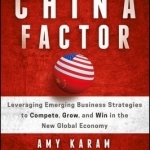
The China Factor: Leveraging Emerging Business Strategies to Compete, Grow, and Win in the New Global Economy
Wiley, Amy Karam and Ken Wilcox
Book
The Innovation of Globalization proven strategies to succeed and out-compete emerging competition...
